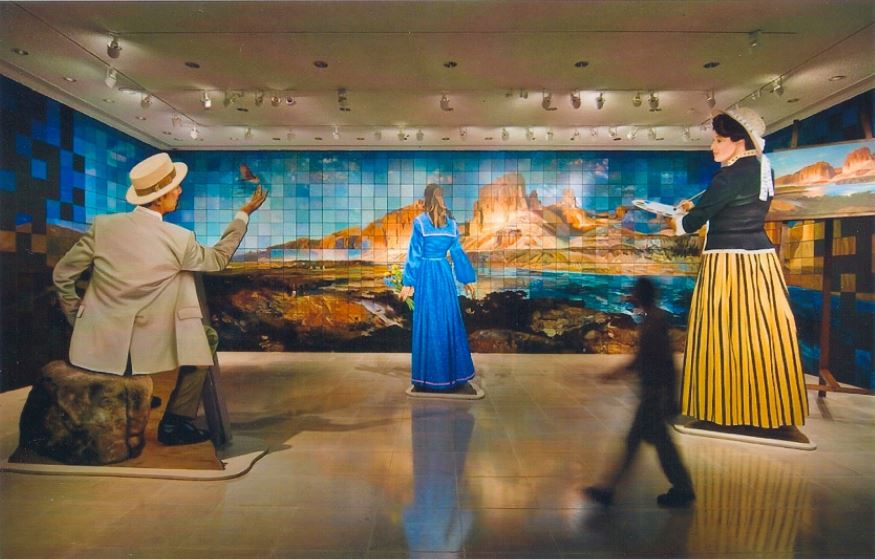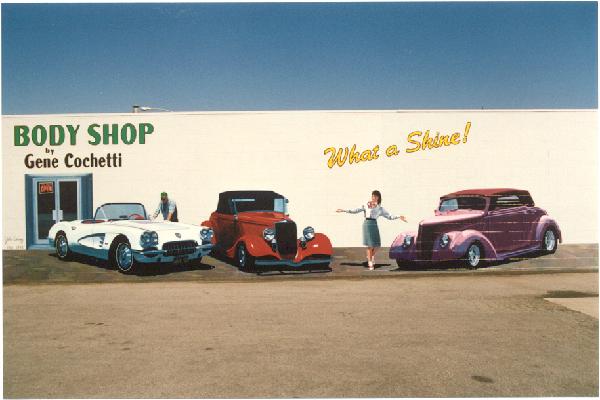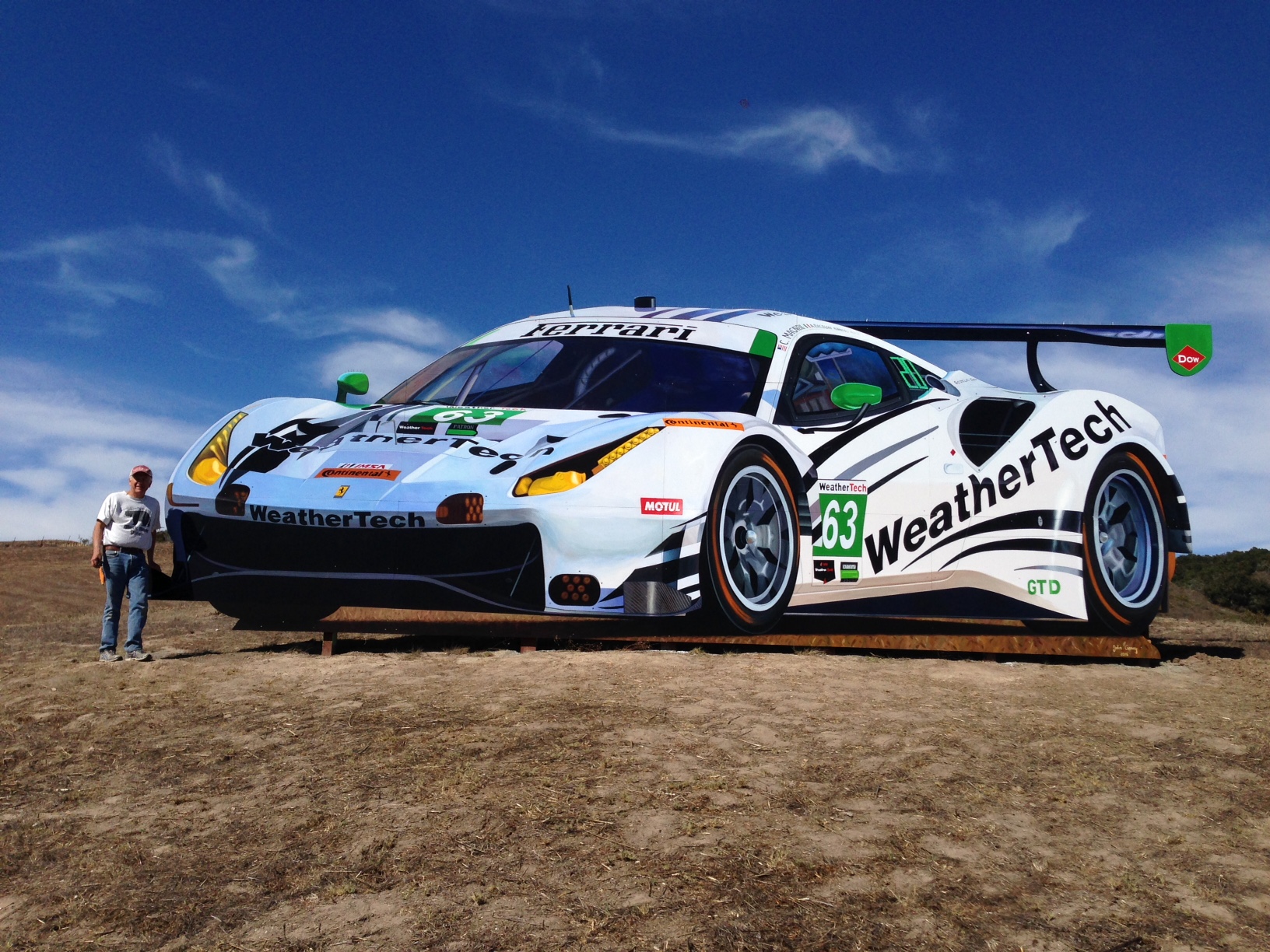
The art of John Cerney has delighted the eyes of audiences along the Midwest and California for decades. The massive roadside cutouts add personality to the land they inhabit while reminding people of the roadside art of a bygone era. https://www.johncerneymurals.com/
What was it like growing up in Salinas when you did? What are some of your most fond memories of those days?
I had a normal childhood growing up in Salinas, although my family probably moved about 15 times from when I was born until I left high school. I attended several schools because of this, so I made different sets of friends along the way. My parents had a loveless type of marriage, but me and my three brothers were never left wanting. They finally divorced when I was a high school senior so by then we were left to our own devices. My childhood was a time when the kids could just go off on our own and find our own fun where we could find it.
My fond memories as a kid aren’t so much about Salinas, but more of the sense of wonderment that most kids experience…going to my first major league ball game, traveling on vacations and seeing things you only saw in magazines, seeing movies at the theater. The kind of magical feelings that as an adult, and with knowledge and experience, I don’t quite feel anymore.


How did you first come to discover your love of art?
I first became enchanted with art, as far as doing it myself, was when I was working in the lettuce business after high school, and in my free time, I decided to paint my old pickup truck…every square inch of it…with all sorts of things. James Dean on the hood! Clint Eastwood….King Tut….cartoons…maps…a Picasso on one of my doors. My very first creation, then, was a public art piece, which I would return to years later. I would leave the lettuce business at 26 and attend a junior college, where I took a few art classes on a whim. It was my slow progression into learning from teachers and artists. I continued on and got an art degree from Cal State Long Beach in Southern California.
I have to add that I did enjoy artistic ‘things’ even younger. In high school, I was the go-to guy to design posters for friends who were running for office, and I also took 3 years of drafting, which gave me a new set of skills that certainly helped along the way.


How did your work progress from portraits to murals? How do the two differ most?
I still do lots of portraits in my mural work…almost all of my work has people in them. I spent my early years as an artist working in Southern California in the TV industry. Then I was doing mostly pencil drawings, for actors, producers and writers. There is certainly more pressure to produce a portrait for a client, so it has to be a good likeness, and even improve upon it if I can. There’s more looseness involved if I’m painting people in my normal outdoor murals, say where a farmer just has to look like a farmer. The viewer doesn’t care at all if it doesn’t look quite like Fred, the model. What I was learning along the way, however, was to get better at replicating the photo I was working from. I feel that now, if I’m working from a good photo, my job is almost done…I just have to paint what I see.


What is the most challenging issue you deal with when working on such a large scale?
What I found after becoming strictly a painter, and working large, is that it’s not as tedious as doing my pencil drawings. My hands can be looser. After a day of drawing with pencils, my fingers and hand would be beat up. The only challenging thing about working larger is that I’m getting older, and handling sheets of plywood, setting posts in the ground, working with concrete…those things are slowly becoming more challenging. I have some neck issues I have to be careful about. There will be a time where I’ll return to my drawing table when working so large becomes tougher.


Do you ever get dizzy having to climb to work on the pieces? If so how do you deal with that?
I never get dizzy, or worry much about heights, but I realize that my scaffold climbing days are numbered. I’m 67 now, and I feel that I’ve got another 7-8 years left in me. Of course, I could pay others to do that part of the job for me, but I haven’t wanted to give up that control yet.


Is there a lot of work that goes in to maintaining the pieces so they are in their best condition? How often do you have to touch them up?
The lifespan of my installations varies, often with what part of the country they’re placed. Anywhere from 7 to 20 years. It’s the downside with working with plywood. It’s a cheap enough material that helps makes the murals affordable to clients. Some of the work I’ve created around Salinas I’ve totally re-done after 10 years, but the usual scenario is that they live out their life, and they then get removed and thrown away. I get the occasional graffiti, which I can repair in my area…and I get the occasional thieves who steal a figure, if they’re the life-sized cutouts. I’ve had three alien figures in a mural in Roswell, NM that have been stolen. What I’ll do is repaint them, and the next time I’m in the general area of Roswell, I’ll stop in and install the new one. The paint I work with is terrific, so there’s not really any ‘touching up’ that takes place. By the time the paint looks bad, the plywood has likely already lived out its life.


Do you still do the occasional portrait or do you focus entirely on murals at this point in your career?
I still get the occasional portrait, but what happened during the pandemic year in 2020 was that I ended up painting 12-13 pet portraits. Businesses were afraid to spend money on ‘frill’ projects from me, so I had to hustle and hit up friends and family for small cutout paintings of their pets. I could attach them to a base and they could sit on a mantle or a desk. People portraits I do once in a while, but only for friends or family. I discourage that from the public, as I still want to concentrate on my public art.


How does it feel to be able to earn a living doing something you love?
I’ve been doing this for so long now that I don’t often even give this question much thought. I do realize, however, that I’m in a small subset of artists who actually make a living at it. I’ve never had to feel the pressure of creating art and HOPING that it sells so I can pay the rent and feed myself. I don’t think that I set out to plan my career with the main objection to make money…two things conspired to make that happen. I work realistically, and early on, I placed my work out in the public. I guaranteed that I’d have a large audience, and that audience included marketing people and businesses. They saw my work and thought of ways themselves to boost their business…that, or the vanity type projects from folks with money.


Do you enjoy being able to remind the public of the roadside art of yesterday through you work today? Why do you think we see less of that now than in the past?
When I think of roadside art of the past, I think more of the whimsical advertisements, like the Burma Shave placards that were erected every few hundred feet with catchy poetic lines, or the large barns with gigantic letters advertising chewing tobacco, or caverns down the road. There were the occasional farmers who would weld tractor parts into farm animals and place them alongside their property line next to a highway.
If there were artists who did what I do now, I’m not aware of it, but there certainly could have been. These sorts of installations don’t have a long life. I think the reason why other artists don’t work like I do is because it really isn’t profitable. I donate one or two of these highway installations a year, and besides the cost of the materials, my travel, and my time, one of these might amount to $20,000 in lost revenue and the cost out of my pocket. It’s just not an enticing proposal for an artist. I’m just fortunate enough to make enough money with my commissions to be able to switch gears and create these pet projects. I know, however, that I benefit by having the public see this side of my work and that it generates new work down the road. It’s like leaving a giant business card with every installation I create.


What projects are you currently working on that we can all look forward to seeing next?
I’m leaving this next week for Memphis, TN to install two giant musical icons, Elvis Presley and Tina Turner. These are commissions from a client who has bought a couple of old buildings near downtown Memphis and is converting one of them into a playful concert setting, with a stage being built that I will place the two 18 feet tall plywood figures on top of, as if they are performing together. The client says that this part of Memphis has been in a state of blight for several years, so he wanted to add some sparkle to the area. I may return this fall to install a few more, including Aretha Franklin, who was born in Memphis. I will also paint a giant Glenn Miller, the Big Band leader, on the outskirts of his hometown of Clarinda, Iowa. That will be later this summer. Currently, I’m painting two giant race cars for the local race track, Laguna Seca in Monterey. I’ve painted 5 cars and a motorcycle for them over the last several years. Because of the pandemic, last year was slow as far as commissions, but it’s rapidly picking up. I’ll take advantage of that and save up for my next personal project. I have 3-4 of those in mind, but none are on the front burner.


What do you hope the viewer takes away from your work?
My audience is the general public, not so much the high brow art connoisseur. I think I connect with my audience because my work is realistic and relatable. I’m a bit like Norman Rockwell in that I compose my scenes like a short story, with moments from everyday life. I’m always looking for a humorous angle. What I’m shooting for by having my work alongside highways is to present some public art for folks who may not visit an art gallery or museum this year, or rarely. They’re in their car simply getting from point A to point B, and they are likely thrown off by spotting these things off to the side of the road. I want that image to linger in their minds for several miles down the road. I am satisfied if they have been entertained on their journey.


Is there anything you’d like to say in closing?
Hmmm…can’t think of anything of substance here…well, maybe this. I’ve been asked if it bothers me that once I’m dead and gone, and my work, which will have withered away shortly after I’m gone, that my career will only exist in photos and memories. My answer is no, since I don’t believe in an afterlife and it will be of no concern of mine how I’m thought of for generations and centuries to come. I’m content with maximizing my time on Earth and to ply my craft as long as I’m able.
What a great interview!! Such fun to read! And as I am already a fan, I love being able to see so many of the other installations!! And, who knew? I am crazy about the new one, the giant cars!! Fantastic!!
Have enjoyed John’s work for many decades since growing up in Salinas. Your admiration for Norman Rockwell is apparent however he never thought of his work enlarged and located in a lettuce field, that’s John Cerney’s genius.